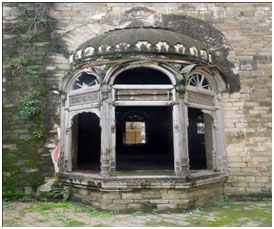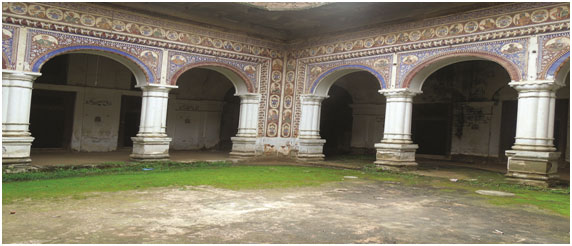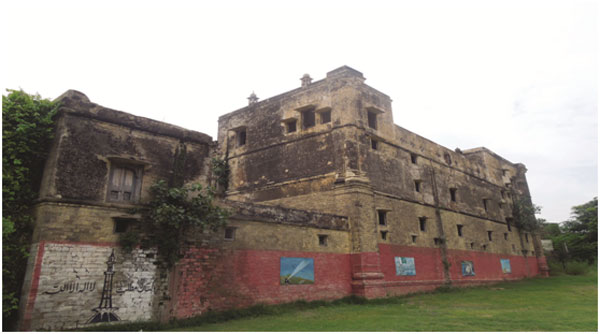The Sikh palace of Kallar Syedan
An Article by Muzammil Shah as appeared in The Dawn, Pakistan on 06 Sep 2015

These paintings represent famous warriors of the subcontinent, of various faiths.
If you ever find yourself in Kallar Syedan, a sub-district of Rawalpindi, just ask around for the ‘Babay Da Mehal’. Locals will guide you through the narrow alleys to this mansion and regale you with myths and traditions associated with the place.
‘Babay Da Mehal’, or ‘Old man’s palace’, is the popular name for the ‘Bedi Palace’, which was built by Baba Khem Singh Bedi in the late 19th century.

A series of murals depicting Sikh gurus. Over the years, visitors have carved their names into the paint.
Born on Feb 21, 1832, in this small district, Baba Khem Singh was a direct descendant of the founder of Sikh religion, Baba Nanak Dev. Khem Singh Bedi was also known as a leading figure in the Singh Sabha Movement, a reformist movement of the Sikh religion.

A jharoka, meant for ventilation, in the courtyard. There would be several of these in such buildings to help ensure air circulation.
According to references available in Sikh history, Baba Khem Singh assisted the British Raj in suppressing a rebellion in Gugera, a town near Okara district, during the 1857 Indian mutiny. In recognition of his services, he was appointed a magistrate in 1877 and was later nominated to the Viceroy’s Legislative Council in 1893.
Baba Khem Singh Bedi was awarded a knighthood in 1898 and died in Montgomery (now Sahiwal) on April 10, 1905.

A beautifully built stone staircase that leads to the upper levels.
It is believed that Bedi Palace was built sometime in the late 19th century and harks back to the glory days of the Bedi family.
The four-storey building is decorated with colourful frescos and murals and built in the typical Sikh style of the colonial period. There is a central courtyard and the structure is supported by a network of pillars. There are plenty of balconies and windows and huge wooden gates greet visitors to this mansion.
The walls and pillars in the central courtyard are decorated with a series of images including paintings of Sikh gurus, warriors, Hindu gods and goddesses. It is also believed that some of the images represent famous Muslim warriors of subcontinent as well. This religious ambiguity is what leads many locals to declare Baba Khem Singh a secular-minded man. But today, much like its original owner’s inclusive ideas, Bedi Palace lies in ruins.

The central courtyard with beautifully adorned pillars.
After partition, the building was used as a government school for boys, but a decade or so ago, the school was shifted to a new building, constructed in front of the palace.
Khalid Qureshi, the school principal, told Dawn: “The palace is in a very dilapidated state and could not be used as a school. We were afraid that the structure would collapse, since many parts of the building are in a really bad state.”

The exterior of the four-storey Bedi Palace.
“We still use the main hall of the palace as an exam hall, but I’m nervous about doing it because the condition of the building is quite dire,” he added. According to Mr Qureshi, the building should now be restored and preserved as a historic landmark of the region. “It can still be restored and preserved if the concerned authorities pay due attention,” he said.

